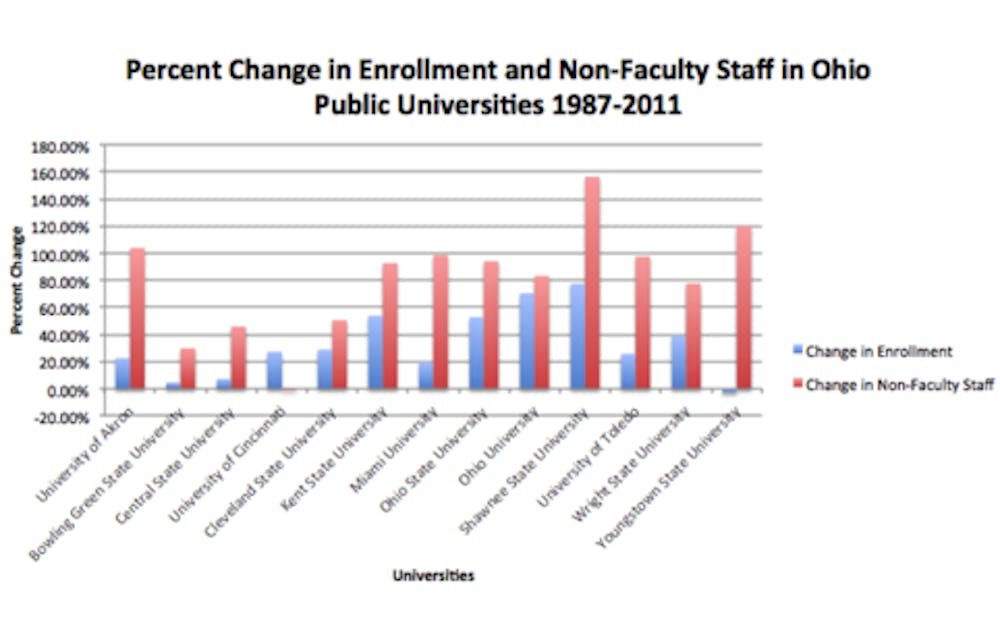Universities across Ohio putting more tuition dollars to employees that don’t have direct, educational influence over students.
It is no secret or surprise that college costs have recently been on the rise. As students struggle to shell out thousands of dollars a year to get their education, many find themselves wondering (probably with some frustration) what exactly is making college so expensive? When we think about higher education costs, what often comes to mind are the more transparent costs, things like room and board and the salaries of professors –costs that students are familiar with and interact with on a day-to-day basis. What we might be less inclined to consider is the rise of university spending on institutional and administrative support.
According to a new study and report by the New England Center of Investigative Reporting, from 1987 to 2011 the number of non-academic administrative and professional employees working at U.S. colleges and universities “has more than doubled.” This might make sense if there had been an equal or greater increase in enrollment rates during this period, but the report also found that the increase in non-academic employees has not only surpassed the increase of students, but also that of teaching faculty. In all Ohio 4-year public schools there was a substantial percent increase in non-academic staff relative to enrollment between 1987 and 2011(see Figure 1.) Considering the paycheck associated with many of these jobs, particularly high-ranking administrators who often make six figures, the cost of this increase becomes apparent.
A study conducted by the Delta Cost Project helps reinforce the findings from the previous study, though this time through the lens of spending. Between 2001 and 2011, public research universities increased spending on institutional support, which includes administrative salaries and other non-academic positions, by almost 11%, while only increasing instructional costs by 4.4%. This shows that schools have chosen to expand their non-instructional departments and services at a greater rate than their instructional ones.
One might question why universities are increasing their administrative and non-academic departments at a greater rate than their academic ones, they are in the business of education after all. A third category of spending considered by the Delta Cost Project may help explain this. From 2001-2011 spending on student services increased by 16.4%, the largest increase of any category, followed by research and institutional support. With increased student services, universities may feel greater pressure to build their administrative bodies in order to accommodate and oversee these new university functions.
Another factor may be that, by the nature of their positions, college administrators wield greater control over university hiring and expansion than their counterparts in instructional positions. It is not inconceivable that administrators hold a bias for their own departments, which may be manifested in the expansion of their employees and salaries. With greater control of university functions and a bias for their own departments, it is easy to see how administrative spending could have increased, at the cost of academic expansion.
It is important to note that increases in student services and college administration are not necessarily a bad thing in, and of, themselves. By increasing these positions, universities are, at least in theory, providing more amenities to their students and better governance for their universities. The problem is that it is hard, if not impossible; to gage what impact this actually has in enhancing students’ academic experience, particularly on an individual basis. Students should ask themselves if the increased non-academic support really helps improve their college experience and keep in mind that while one student might benefit tremendously from increased administrative spending, another may see no benefit at all.
The real problem is that regardless of how much a university’s non-academic spending affects each student’s experience, all students are affected by changes in tuition which, according to 2000 to 2010 data from the College Board, have increased by almost 63% at public 4-year universities. It would be one thing if students could be assured that this increase was due to an expansion in the quality of their academic departments, but unfortunately it appears to have more to do with non-academic spending.
Robert Hammer is a junior studying anthropology and economics at Ohio University and a research assistant at the Center for College Affordability and Productivity. Columns will be written by a different CCAP student from Ohio University each week. Email Robert at Rh637212@ohio.edu.






